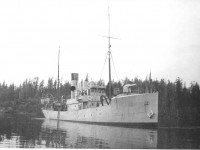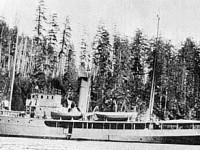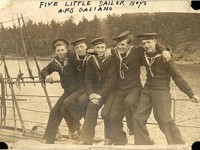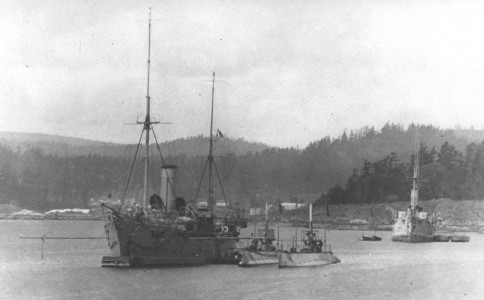In the early 1900s, Esquimalt was seen as a prospective bastion of the British Empire. When Britain’s Royal Navy withdrew from the Canadian stage in 1904, leaving only two small ships, the Canadian coasts were left with scant naval protection. Finally six years later in 1910, the Royal Canadian Navy was formed that would be modelled on Royal Navy standards, ranks and discipline. When war broke out in 1914, over 9,000 Canadians enlisted in the RCN, but the RCN retained only about 1000 recruits while the rest served with Britain’s Royal Navy as reserves. 43

The Royal Naval Canadian Volunteer Reserve had been formed the previous year, on August 5, 1913 and was officially recognized in May 1914. Composed of two companies, No. 1 Victoria and No. 2 Vancouver, it was considered to be “one of the most efficient volunteer naval units in existence”.44
When war broke out in 1914, of the approximately 750 enlisted, 211 naval volunteers were stationed at Esquimalt. Thirty seven served on HMCS Rainbow and a number served in Royal Navy submarines. About 200 were sent to Halifax to serve on HMCS Niobe and HMS Diana, and to participate in patrol duties. The remainder were not restricted to naval service; they served in the Army Service Corps, the regular army and the Army Medical Corps as well as in the Royal Flying Corps.Some of the naval volunteers are in the trenches in Flanders while others have joined the Army Service Corps and the Army Medical Corps, and not a few are now serving with the Royal Flying Corps. 45
-
The Royal Canadian Navy’s First Fleet
Canada in 1910 had only two naval bases –the one at Esquimalt and the other was in Halifax. Since the Halifax and Esquimalt naval bases hadn’t cost the Canadian government virtually anything, Prime Minister Sir Wilfred Laurier wanted to use the navy’s budget to launch a shipbuilding program and provide the new navy with four cruisers and six destroyers that would be built in Canada and manned by Canadians. Laurier however was defeated in the 1911 election by his rival Robert Borden who was against the program, and the ships were never built. 46

When war broke out in 1914, the fleet of the entire Canadian navy was made up of two Royal Navy ships, one of which was HMCS Rainbow stationed at Esquimalt and HMCS Niobe in Halifax. On the west coast, HMCS Galiano and her sister ship the Malaspina, that were fisheries patrol vessels was also requisitioned for the fledging RCN in 1917. 47

The Rainbow, Galiano and Malaspina were to patrol the west coast of British Columbia on the lookout for German ships. The Malaspina engaged in servicing radio stations and lighthouses but was severely damaged during one of these runs. The Galiano, just returned from the Queen Charlottes, was quickly sent out again, despite requiring servicing. On October 29, after

unloading supplies at Triangle Island, she headed out into the same gale that two days earlier had caused the sinking of the Princess Sophia. She went down with all hands; none of the 38 crew survived, and only three of the bodies were recovered. 48
When Japan entered the war on the 23rd of August, 1914 on the side of the Allies, a few Japanese ships such as the Aso also helped patrol Pacific waters. 49 HMCS Armentières arrived in Esquimalt, coming from Montreal in 1918 and served as a training ship for the naval reserves.
-
A Royal Canadian Naval Hospital Ship
The RCN also had one hospital ship, HMCHS Prince George that had formerly been a CNR cruise ship. It was brought to the Esquimalt drydock for an extensive refit; being outfitted with 200 beds, and painted with a Red Cross on the funnel. It left the dock with six nursing sisters who were the RCN’s first women recruits, and headed for Prince Rupert from where it was supposed to cruise overseas to Hong Kong. On the way, the ship stopped at Juneau Alaska and received orders to proceed to the nearest British port, which happened to be the port it had just left, Prince Rupert. Then the ship returned to Esquimalt for an inspection and for some reason was never sent overseas. Its war career came to an end after just 45 days. 50
-
The Navy Acquires Two Submarines
One of the most significant acquisitions by the RCN was two submarines, the CC1 and CC2, that would augment the navy’s tiny coastal defence fleet. Although neither submarine had a distinguished naval career, the story of their acquisition is one of both intrigue and deception. 51

On the eve of World War I, the Premier of British Columbia, Sir Richard McBride undertook a scheme to relocate two submarines from Seattle to the naval base in Esquimalt. He had to act quickly since the United States was neutral and once war broke out would be unable to supply war materials to countries involved in the conflict.
 The submarines had been intended for the Chilean navy, however, the president of the Seattle Construction and Drydock Company, Mr. J. V. Paterson, was willing to turn them over to the Canadian navy for the steep fee of one million dollars, which represented double the navy’s budget for two years.
The submarines had been intended for the Chilean navy, however, the president of the Seattle Construction and Drydock Company, Mr. J. V. Paterson, was willing to turn them over to the Canadian navy for the steep fee of one million dollars, which represented double the navy’s budget for two years.
On August 4, 1914, travelling in darkness, the Canadian steamship Salvor slipped southward for a rendezvous with Paterson and the two submarines at Trial Island. Dawn was breaking as they met. After a four hour long inspection, the Canadians handed over a cheque to Paterson and the submarines headed north to their new home in Esquimalt. 52
Almost a year later, in June 1915, McBride was up before the Royal Commission in Ottawa defending his purchase. His argument before the Commission below, could be said to echo the feelings of residents on the west coast of Canada, who often felt estranged by decisions made at the nation’s capital. “Because of the existence in local waters of two German warships,” said Sir Richard, “and the defenceless nature of our coast cities, there was a great deal of nervous tension among our people. It appeared to me that something should be done to afford home protection for our coast cities. We are 3,000 miles from Ottawa, and it is not always easy to get immediate connection. I, therefore, took upon my own responsibility to purchase these vessels, and I intended to have the Province of British Columbia foot the bill, if, in its wisdom the Federal Government considered the step to have been unwise. 53
It is difficult,” continued Sir Richard, “to make the people of Ottawa understand the undefended condition of our coast. This is not the occasion to talk of defence, but I have expressed myself freely at other times.”54
Although the two submarines were to be named McBride and Paterson after the men who made the deal, instead, they were called CC1 and CC2 following Australian precedent. As small submarines they were ideal for patrolling the coast between Vancouver Island and the BC mainland, but by 1917, when the threat of German warships no longer loomed, it was decided to send them overseas. They made their way to Halifax, but by the time they reached their destination, they both needed new engines. Instead of serving in the European war, they were judged unfit and taken out of service. In 1920, the million dollar submarines were sold for scrap. 55
by Catherine Gilbert
